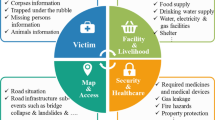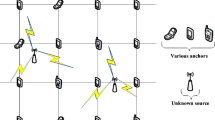Abstract
The use of crowd-sensing networks is a promising and low-cost way for identifying low-level radiation sources, which is greatly important for the security protection of modern cities. However, it is challenging to identify radiation sources based on inaccurate crowd-sensing measurements with unknown sensor efficiency, due to uncontrollable nature of users. However, existing methods assume the sensor efficiency is available, while their identification accuracy tightly depends on identification threshold. To address these problems, we present Counter-Strike, an accurate and robust identification method. Specifically, we use truthful probability of sources for robust identification. And then, we propose an iterative truthful-source identification algorithm, alternately iterating between sensor efficiency estimation and truthful probability estimation, gradually improving the identification accuracy. The extensive simulations and theoretical analysis show that our method can converge into the maximum likelihood of crowd-sensing measurements, achieving much higher identification accuracy than the existing methods. Further, the identification threshold makes slight influence on the identification accuracy in our method, facilitating its practical use.








Similar content being viewed by others
Notes
Counter-Strike [26] is a video game in which the counters are searching and identifying the terrorists, then killing them. Similar to it, our method aims at accurately identifying the radiation sources which pose threat to the city security.
References
Bickel PJ, Li B (1977) Mathematical statistics. Test 15
Chin JC, Rao NSV, Yau DKY, Shankar M, Yang Y, Hou JC, Srivathsan S, Iyengar S (2010) Identification of low-level point radioactive sources using a sensor network. ACM Trans Sens Netw 7(3):1–35
Chin JC, Yau DKY, Rao NSV (2011) Efficient and robust localization of multiple radiation sources in complex environments. In: ICDCS, IEEE, pp 780–789
Chin JC, Yau DKY, Rao NSV, Yang Y, Ma CYT, Shankar M (2008) Accurate localization of low-level radioactive source under noise and measurement errors. In: Sensys
Dempster A, Laird N, Rubin D (1977) Maximum likelihood from incomplete data via the em algorithm. J R Stat Soc Ser B 39(1):1–38
Eisenman S, Miluzzo E, Lane N, Peterson R, Ahn G, Campbell A (2009) Bikenet: a mobile sensing system for cyclist experience mapping. ACM Trans Sens Netw 6(1):6
Fu Z, Wu X, Guan C, Sun X, Ren K (2016) Toward efficient multi-keyword fuzzy search over encrypted outsourced data with accuracy improvement. IEEE Trans Inf Forensics Secur 11(12):2706–2716
Ganti RK, Ye F, Lei H (2011) Mobile crowdsensing: current state and future challenges. IEEE Commun Mag 49(11):32–39
Hasenfratz D, Saukh O, Sturzenegger S, Thiele L (2012) Participatory air pollution monitoring using smartphones. In: International workshop on mobile sensing. Beijing, China
Hull B, Bychkovsky V, Zhang Y, Chen K, Goraczko M, Miu A, Shih E, Balakrishnan H, Madden S (2006) Cartel: a distributed mobile sensor computing system. In: Sensys
Jeremic A, Nehorai A (2000) Landmine detection and localization using chemical sensor array processing. IEEE Trans Signal Process 48(5):1295–1305
Khan W, Xiang Y, Aalsalem M, Arshad Q (2012) Mobile phone sensing systems: a survey. IEEE Commun Surv Tutor 15(1):402–427
Lane ND, Miluzzo E, Lu H, Peebles D, Choudhury T, Campbell AT (2010) A survey of mobile phone sensing. IEEE Commun Mag 48(9):140–150
Li J, Li X, Yang B, Sun X (2015) Segmentation-based image copy-move forgery detection scheme. IEEE Trans Inf Forensics Secur 10(3):507–518
Liu AH, Bunn JJ, Chandy KM (2011) Sensor networks for the detection and tracking of radiation and other threats in cities. In: Information processing in sensor networks (IPSN). IEEE, pp 1–12
Ma H, Zhao D, Yuan P (2014) Opportunities in mobile crowd sensing. IEEE Commun Mag 52(8):29–35
Mathur S, Jin T, Kasturirangan N, Chandrasekaran J, Xue W, Gruteser M, Trappe W (2010) Parknet: drive-by sensing of road-side parking statistics. In: Mobisys. ACM, pp 123–136
Mohan P, Padmanabhan VN, Ramjee R (2008) Nericell: rich monitoring of road and traffic conditions using mobile smartphones. In: SenSys. ACM, pp 323–336
Nawaz S, Efstratiou C, Mascolo C (2013) Parksense: a smartphone based sensing system for on-street parking. In: Mobicom, pp 75–86
Nehorai A, Porat B, Paldi E (1995) Detection and localization of vapor-emitting sources. IEEE Trans Signal Process 43(1):243–253
Rana R, Chou C, Kanhere S, Bulusu N, Hu W (2010) Ear-phone: an end-to-end participatory urban noise mapping system. In: IPSN, pp 105–116
Rao NS, Shankar M, Chin JC, Yau DK, Ma CY, Yang Y, Hou JC, Xu X, Sahni S (2008) Localization under random measurements with application to radiation sources. In: International conference on information fusion. IEEE, pp 1–8
Rao NSV, Shankar M, Chin JC, Yau DKY, Srivathsan S, Iyengar SS, Yang Y, Hou JC (2008) Identification of low-level point radiation sources using a sensor network. In: IPSN. IEEE, pp 493–504
Ren YJ, Shen J, Wang J, Han J, Lee SY (2015) Mutual verifiable provable data auditing in public cloud storage. J Internet Technol 16(2):317–323
Sundaresan A, Varshney PK, Rao NS (2007) Distributed detection of a nuclear radioactive source using fusion of correlated decisions. In: International conference on information fusion. IEEE, pp 1–7
Wikipedia (2016) Counter-strike. https://en.wikipedia.org/wiki/Counter-Strike. Accessed 1 August
Wu CFJ (1983) On the convergence properties of the em algorithm. Ann Stat 11(1):95–103
Xia Z, Wang X, Sun X, Wang Q (2016) A secure and dynamic multi-keyword ranked search scheme over encrypted cloud data. IEEE Trans Parallel Distrib Syst 27(2):340–352
Xiang C, Yang P, Tian C, Yan Y, Wu X, Liu Y (2013) Passfit: participatory sensing and filtering for identifying truthful urban pollution sources. IEEE Sens J 13(10):3721–3732
Xiang C, Yang P, Tian C, Zhang L, Lin H, Xiao F, Zhang M, Liu Y (2016) Carm: crowd-sensing accurate outdoor rss maps with error-prone smartphone measurements. IEEE Trans Mob Comput 15(11):2669–2681
Xing G, Wang J, Yuan Z, Tan R, Sun L, Huang Q, Jia X, So HC (2010) Mobile scheduling for spatiotemporal detection in wireless sensor networks. IEEE Trans Parallel Distrib Syst 21(12):1851–1866
Yang Y, Hou H, Hou JC (2009) Sensor placement for detecting propagative sources in populated environments. In: INFOCOM. IEEE, pp 1206–1214
Zhang Y, Sun X, Wang B (2016) Efficient algorithm for k-barrier coverage based on integer linear programming. China Commun 13(7):16–23
Zhangjie F, Xingming S, Qi L, Lu Z, Jiangang S (2015) Achieving efficient cloud search services: multi-keyword ranked search over encrypted cloud data supporting parallel computing. IEICE Trans Commun 98(1):190–200
Zhao T, Nehorai A (2006) Detecting and estimating biochemical dispersion of a moving source in a semi infinite medium. IEEE Trans Signal Process 54(6):2213–2225
Acknowledgements
This research is partially supported by Jiangsu Distinguished Young Scholar Awards, NSF China under Grants Nos. 61502520, 61272487, 61232018, 61632010, 61602067, 61672038, 61632010 and BK20150030, CSTC2016JCYJA0053.
Author information
Authors and Affiliations
Corresponding author
Rights and permissions
About this article
Cite this article
Xiang, C., Yang, P. & Xiao, S. Counter-strike: accurate and robust identification of low-level radiation sources with crowd-sensing networks. Pers Ubiquit Comput 21, 75–84 (2017). https://doi.org/10.1007/s00779-016-0976-y
Received:
Accepted:
Published:
Issue Date:
DOI: https://doi.org/10.1007/s00779-016-0976-y




